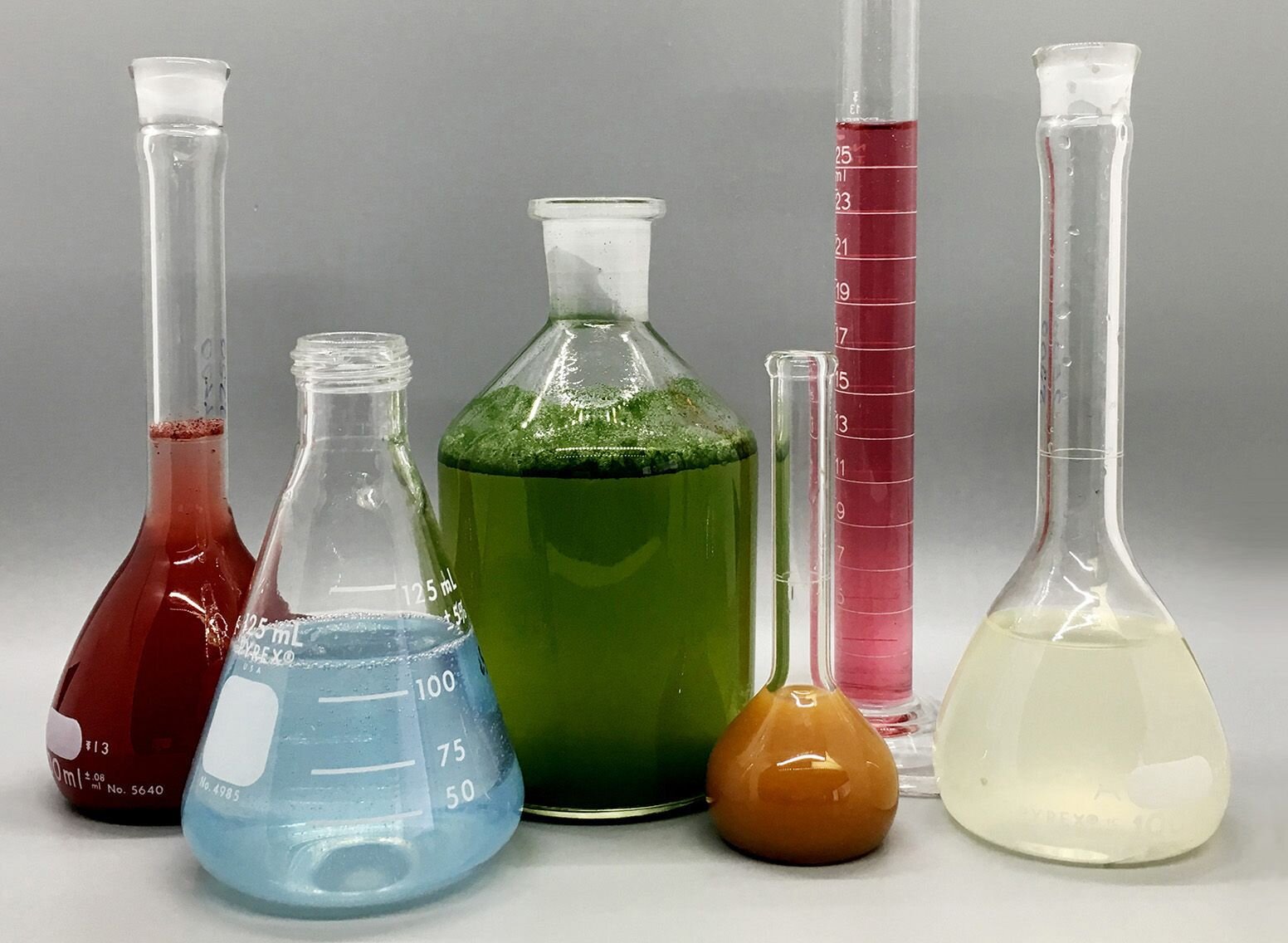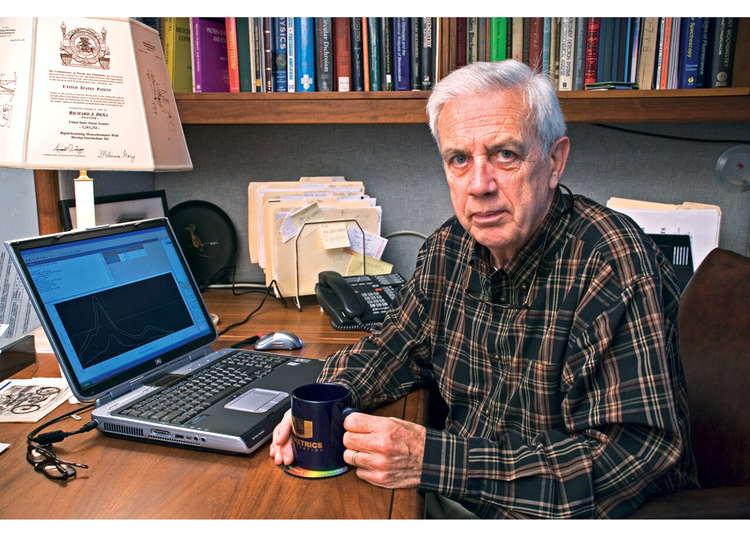9 Simple Techniques For Spectrophotometers
9 Simple Techniques For Spectrophotometers
Blog Article
The Single Strategy To Use For Spectrophotometers
Table of ContentsThings about Circularly Polarized LuminescenceThe Best Strategy To Use For SpectrophotometersLittle Known Questions About Circular Dichroism.Circularly Polarized Luminescence Things To Know Before You BuyAbout Uv/visSome Known Details About Circularly Polarized Luminescence Indicators on Circular Dichroism You Should KnowFacts About Uv/vis/nir UncoveredExcitement About SpectrophotometersThe 25-Second Trick For Uv/vis/nirThe Only Guide to Uv/vis/nirRumored Buzz on Circularly Polarized LuminescenceFacts About Uv/vis Uncovered
It is then scanned through the sample and the recommendation options. Portions of the incident wavelengths are transmitted through, or shown from, the sample and the reference. The resultant light strikes the photodetector device, which compares the relative intensity of the two beams. Electronic circuits transform the relative currents into linear transmission percentages and/or absorbance/concentration worths.The transmission of a recommendation substance is set as a baseline (datum) value, so the transmission of all other substances are taped relative to the initial "zeroed" compound. The spectrophotometer then converts the transmission ratio into 'absorbency', the concentration of specific parts of the test sample relative to the preliminary substance.
Considering that samples in these applications are not easily offered in big quantities, they are specifically matched to being evaluated in this non-destructive strategy. In addition, valuable sample can be saved by using a micro-volume platform where just 1u, L of sample is needed for total analyses. A short description of the treatment of spectrophotometry consists of comparing the absorbency of a blank sample that does not consist of a colored compound to a sample that consists of a colored compound.
Excitement About Circular Dichroism
In biochemical experiments, a chemical and/or physical property is picked and the procedure that is used is specific to that residential or commercial property in order to obtain more details about the sample, such as the quantity, pureness, enzyme activity, etc. Spectrophotometry can be utilized for a number of strategies such as figuring out optimal wavelength absorbance of samples, identifying ideal p, H for absorbance of samples, figuring out concentrations of unidentified samples, and determining the p, Ka of different samples.: 21119 Spectrophotometry is likewise a helpful process for protein purification and can also be utilized as an approach to produce optical assays of a compound.
It is possible to know the concentrations of a two element mixture using the absorption spectra of the standard options of each component. To do this, it is required to understand the extinction coefficient of this mixture at 2 wave lengths and the extinction coefficients of solutions that consist of the known weights of the two elements.

Not known Incorrect Statements About Circularly Polarized Luminescence
A lot of spectrophotometers are used in the UV and noticeable regions of the spectrum, and some of these instruments likewise run into the near-infrared area also. The concentration of a protein can be approximated by measuring the OD at 280 nm due to the presence of tryptophan, tyrosine and phenylalanine (https://pblc.me/pub/3fc0b3e264b77b).
Nucleic acid contamination can likewise interfere. This method needs a spectrophotometer capable of determining in the UV area with quartz cuvettes.: 135 Ultraviolet-visible (UV-vis) spectroscopy involves energy levels that excite electronic shifts. Absorption of UV-vis light delights molecules that are in ground-states to their excited-states. Noticeable area 400700 nm spectrophotometry is utilized extensively in colorimetry science.
20. 8 O.D. Ink makers, printing companies, textiles suppliers, and many more, require the information provided through colorimetry. They take readings in the area of every 520 nanometers along the noticeable area, and produce a spectral reflectance curve or an information stream for alternative presentations. These curves can be used to evaluate a brand-new batch of colorant to inspect if it makes a match to requirements, e.
The Ultimate Guide To Uv/vis/nir
Traditional visible area spectrophotometers can not spot if a colorant or the base material has fluorescence. This can make it tough to handle color problems if for example one or more of the printing inks is fluorescent. Where a colorant consists of fluorescence, a bi-spectral fluorescent spectrophotometer is used (https://urlscan.io/result/3823bc3a-74b6-4d0f-8f09-522e983b4d26/). There are two significant setups for visual spectrum spectrophotometers, d/8 (round) and 0/45.
Scientists utilize this instrument to determine the amount of substances in a sample. In the case of printing measurements 2 alternative settings are frequently utilized- without/with uv filter to control much better the effect of uv brighteners within the paper stock.
The Ultimate Guide To Circularly Polarized Luminescence
Some applications require little volume measurements which can be performed with micro-volume platforms. As described in the applications section, spectrophotometry can be used in both qualitative and quantitative analysis of DNA, RNA, and proteins. Qualitative analysis can be utilized and spectrophotometers are used to tape spectra of compounds by scanning broad wavelength regions to determine the absorbance properties (the intensity of the color) of the compound at each wavelength.

The 8-Second Trick For Uv/vis
One significant element is the kind of photosensors that are offered for various spectral areas, however infrared measurement is also difficult because essentially everything gives off IR as thermal radiation, specifically at wavelengths beyond about 5 m. Another problem is that many products such as glass and plastic absorb infrared, making it incompatible as an optical medium.
Samples for IR spectrophotometry might be smeared between 2 discs of potassium bromide or ground with potassium bromide and pushed into a pellet. Where aqueous services are to be measured, insoluble silver chloride is utilized to construct the cell. Spectroradiometers, which run practically like the noticeable region spectrophotometers, are designed to measure the spectral density of illuminants. 2013. p. 13. Allen, DW; Cooksey, C; Tsai, BK (Nov 13, 2009). "Spectrophotometry". Obtained Dec 23, 2018. Ninfa AJ, Ballou DP, Benore M (2010 ). Essential Lab Techniques for Biochemistry and Biotechnology (second ed.). Hoboken: Wiley & Sons. ISBN 9780470087664. OCLC 488246403. Schwedt G (1997 ). The necessary guide to analytical chemistry.
Chichester, NY: Wiley. pp. 1617. ISBN 9780471974123. OCLC 36543293. Ninfa AJ, Ballou DP (2004 ). Essential lab methods for biochemistry and biotechnology. Hoboken: Wiley. p. 66. ISBN 9781891786006. OCLC 633862582. Rendina G (1976 ). Philadelphia, PA: W. B. Saunders Business. pp. 46-55. ISBN 0721675506. OCLC 147990. Oke, J. B.; Gunn, J. E.
Some Known Details About Uv/vis
"Secondary basic stars for absolute spectrophotometry". The Astrophysical Journal. 266: 713. Bibcode:1983 Ap, J..266..713 O. doi:10. 1086/160817. Ishani, G (2006 ). "The very first commercial UV-vis spectrophotometer". p. 100. Obtained Dec 23, 2018. Simoni, RD; Hill, RL; Vaughan, M; Tabor, H (Dec 5, 2003). "A Timeless Instrument: The Beckman DU Spectrophotometer and Its Inventor, Arnold O.
278 (49 ): e1. doi:. ISSN 1083-351X. Beckman, A. O.; Gallaway, W. S.; Kaye, W.; Ulrich, W. F. (March 1977). "History of spectrophotometry at Beckman Instruments, Inc". Analytical Chemistry. 49 (3 ): 280A300A. doi:10. 1021/ac50011a001. "Hewlett Packard: Substance Recognition with HP 8450 A UV Noticeable Spectrophotometer". Analytical Chemistry. 51 (12 ): 1188A1189A. 1979-10-01.
1021/ac50048a728. ISSN0003-2700. Ninfa AJ, Ballou DP, Benore M (2015 ). Fundamental Lab Approaches for Biochemistry and Biotechnology (3, rev. ed.). Hoboken, NJ: Wiley & Sons. p. 77. ISBN9780470924525. OCLC915641828. "Fully Automatic Double Beam - Atomic Absorption Spectrophotometer (AA 8000)". Lab Devices. Labindia Analytical Instruments Pvt. Ltd. "Spectrophotometry Applications and Principles".
Fascination About Uv/vis/nir
Obtained Jul 4, 2018. Trumbo, Toni A.; Schultz, Emeric; Borland, Michael G.; Pugh, Michael Eugene (April 27, 2013). "Applied Spectrophotometry: Analysis of a Biochemical Mix". Biochemistry and Molecular Biology Education. 41 (4 ): 24250. doi:10. 1002/bmb. 20694. PMID 23625877. (PDF). www. mt.com. Mettler-Toledo AG, Analytical. 2016. Recovered Dec 23, 2018. Cortez, C.; Szepaniuk, A.; Gomes da Silva, L.
"Exploring Proteins Purification Strategies Animations as Tools for the Biochemistry Mentor". Journal of Biochemistry Education. 8 (2 ): 12. doi:. Garrett RH, Grisham CM (2013 ). Biochemistry. Belmont, CA: Cengage. p. 106. ISBN 978-1133106296. OCLC 801650341. Holiday, Ensor Roslyn (May 27, 1936). "Spectrophotometry of proteins". Biochemical Journal. 30 (10 ): 17951803. doi:10. 1042/bj0301795.
PMID 16746224. Hermannsson, Ptur G.; Vannahme, Christoph; Smith, Cameron L. C.; Srensen, Kristian T.; Kristensen, Anders (2015 ). "Refractive index dispersion picking up utilizing a selection of photonic crystal resonant reflectors". Applied Physics Letters. 107 (6 ): 061101. Bibcode:2015 Ap, Ph, L. 107f1101H. doi:10. 1063/1. 4928548. S2CID 62897708. Mavrodineanu R, Schultz JI, Menis O, eds.
Uv/vis Things To Know Before You Get This
U.S. Department of Commerce National Bureau of Standards unique publication; 378. Washington, D.C.: U.S. National Bureau of Standards. p. 2. OCLC 920079.
The process starts with a controlled light that brightens the evaluated sample. When it comes to reflection, as this light connects with the sample, some is taken in or given off. The given off light travels to the detector, which is examined, measured, and provided as industry-standard color scales and indices.
Industry governing bodies usually define particular metrics for particular products, such as Tomato and Coffee indices. The streamlined math looks like this: Where R is the reflection coefficient. All terms are evaluated over the navigate to this website noticeable spectrum from 400 to 700 nm. When it comes to transmission, when the light interacts with the sample, it is either absorbed, shown, or sent.
Things about Uv/vis/nir
Examples include APHA (American Public Health Association) for watercolor and purity analysis, ASTM D1500 for petrochemical color analysis, edible oil indices used in food, and color analyses of drinks. All terms are examined over the noticeable spectrum from 400 to 700 nm.
Image Credit: Matej Kastelic/ Dr. Arnold J. Beckman and his associates at the National Technologies Laboratories first invented the spectrophotometer in 1940. In 1935 Beckman established the company, and the discovery of the spectrophotometer was their most ground-breaking creation. Dr. Bruce Merrifield, a Nobel prize-winning biochemist, mentioned that the innovation of the spectrophotometer was "most likely the most crucial instrument ever established towards the development of bioscience." Before the discovery of the spectrophotometer, chemical analyses took weeks to finish, with 25% accuracy.
The Facts About Uv/vis/nir Revealed
Over time, researchers kept enhancing the spectrophotometer style to boost its performance. The UV capabilities of the model B spectrophotometer were enhanced by replacing the glass prism with a quartz prism.
After 1984, double-beam versions of the gadget were created. The addition of external software application with the arrangement of onscreen screens of the spectra came in the 1990s. Typically, a spectrophotometer is made up of 2 instruments, particularly, a spectrometer and a photometer. A basic spectrophotometer includes a light, a monochromator, a collimator for straight beam transmission, a cuvette to position a sample, and a photoelectric detector.
Fascination About Circular Dichroism
There are various types of spectrophotometers in different sizes and shapes, each with its own purpose or functionality. A spectrophotometer determines just how much light is shown by chemical components. spectrophotometers. It measures the difference in light strength based upon the overall quantity of light introduced to a sample and the quantity of light beam that travels through the sample service
Based on the instrument's style, the sample is positioned between the spectrometer and the photometer. After the light is gone through the sample, the photometer determines its strength and displays the reading. A spectrophotometer is used to figure out the concentration of both colorless and colored solutes in an option. This instrument is utilized to identify the rate of a response.
Report this page